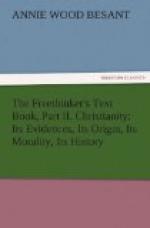Zorababel is the son of Pedaiah, according to Matthew,
he is the son of Salathiel, according to Luke, he is
the son of Neri; according to Chronicles, Zorobabel
left eight children, but neither Matthew’s Abiud,
nor Luke’s Rhesa, are among them. The same
discordance is found when Matthew and Luke again touch
each other in Joseph, the husband of Mary; according
to the one, Jacob begat Joseph, according to the other,
Joseph was the son of Heli. To crown the absurdity
of the whole, we are given two genealogies of Joseph,
who is no relation to Jesus at all, if the story of
the virgin-birth be true, while none is given of Mary,
through whom alone Jesus is said to have derived his
humanity. We have, therefore, no genealogy at
all of Jesus in the Gospels. Various theories
have been put forward to reconcile the irreconcilable;
some say that the genealogy in Luke is that of Mary,
of which supposition it is enough to remark that “Mary,
the daughter of,” can scarcely be indicated
by “Joseph, the son of.” It is also
said that Joseph was legally the son of Jacob, although
naturally the son of Heli, it being supposed that
Jacob died childless, and that his brother Heli according
to the Levitical law, married the widow of Jacob; but
here Joseph’s grand-fathers and great-grand-fathers
should be the same, Heli and Jacob being supposed
to be brothers. Besides, if Joseph were legally
the son of Jacob, only the genealogy of Jacob should
be given, since that only would be Joseph’s
genealogy. No man can reckon his paternal ancestry
through two differing lines. To make matters in
yet more hopeless confusion, we find Chronicles giving
twenty-two generations where Matthew gives seventeen,
and Luke twenty-three; while, from David to Christ,
Matthew reckons twenty-eight and Luke forty-three,
a most marvellous discrepancy.
“If we compare the genealogies of Matthew and
Luke together, we become aware of still more striking
discrepancies. Some of these differences indeed
are unimportant, as the opposite direction of the two
tables.... More important is the considerable
difference in the number of generations for equal
periods, Luke having forty-one between David and Jesus,
whilst Matthew has only twenty-six. The main difficulty,
however, lies in this: that in some parts of
the genealogy in Luke totally different persons are
made the ancestors of Jesus from those in Matthew.
It is true, both writers agree in deriving the lineage
of Jesus through Joseph from David and Abraham, and
that the names of the individual members of the series
correspond from Abraham to David, as well as two of
the names in the subsequent portion: those of
Salathiel and Zorobabel. But the difficulty becomes
desperate when we find that, with these two exceptions
about midway, the whole of the names from David to
the foster father of Jesus are totally different in
Matthew and in Luke. In Matthew the father of
Joseph is called Jacob; in Luke, Heli. In Matthew
the son of David through whom Joseph descended from




